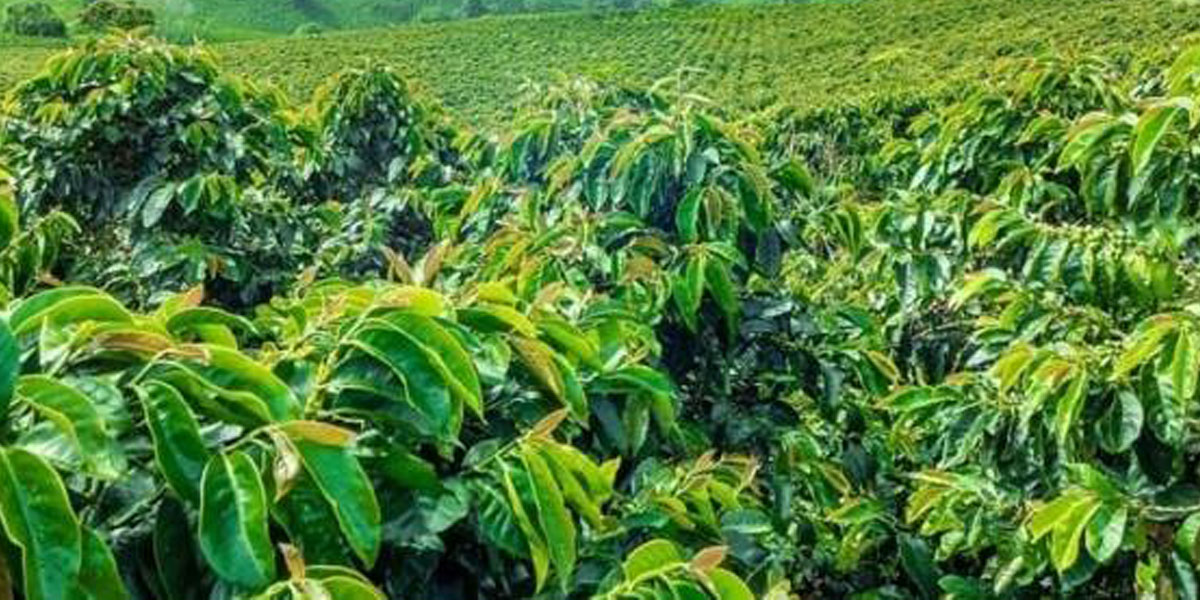Coffee coffee plantation arabica coffee harvest
Several species of shrub of the genus Coffea produce the berries from which coffee is extracted. The two main species cultivated commercially are Coffea canephora - better known as 'robusta' - and Coffea arabica. Both are cultivated at the Ijen Plateau.
Arabica is native to the southwestern highlands of Ethiopia and the Boma Plateau in southeastern Sudan and possibly Mount Marsabit in northern Kenya. The robusta strain arrived in Java around 1900. Canephora is native to western and central subsaharan Africa, from Guinea to the Uganda and southern Sudan. In Java both species are commonly used over the years. At the plantation Blawan and Kalisat at the Ijen Plateau mainly Arabica is grown.
Coffee fields at Ijen Plateau
At the Ijen Plateau you find fields that look like wasteland, those full with coffee shrub and those with not only coffee but also orange trees, macadamia nuts and trees for shade. Those unused lands are waiting for the seedlings that are grown in greenhouses. Seedlings are planted in the fields after they have fully been taking care of for 1 year.
Sometimes fields that look empty aren't. Old coffee trees are cut about 50 centimeters above the soil. This is also called the Ijen Pruning System. The plants are cut because production dropped. But, their root system is still very strong. These coffee plants will sprout again and come back into production. At the Ijen Plateau the coffee plantations are diversifying, in particular in Kalisat. Nowadays, oranges and macadamia nuts are inter-cropped with coffee. Otherwise, strawberries are a sold as far as Bali. Greenhouses and modern experiments
Greenhouses and modern experiments
Coffee is sown in greenhouses in Blawan. The seedlings grow fully covered by plastic for three months. Then, the plastic is taken of and the seedlings will grow till an age of 1 year in the open air. If they reached that age, they are planted in the fileds at the Ijen Plateau.
Because of problems with the roots of the arabica coffee plants, a grafting experiment - based on results of the coffee plantation in Jember - was started a few years ago. Robusta forms the stem, while arabica is on top.
Large differences in productivity
Only Coffea arabica and Coffea canephora are commercialized out of the more than 60 existing species. From each species there are several varieties with different flavours, but also large differences in terms of productivity. Productivity can range between 3 to 12 tonnes per hectare. While arabica can fertilize itself, robusta needs a male and a female tree to reproduce. The quality of the coffee depends on several factors: botanical species and variety, terrain, temperature, altitude, sun exposure, amount of light (shade), water (irrigation) and wind.
Coffee seedlings at the Ijen Plateau
'Arabian jasmine'It takes 5 years from seedling till harvest. A coffee plant bears flowers after three years. After another two years, the first coffee can be harvested. In Kalisat it depends on the production per hectare whether the management decides the trees are fully grown and the beans are ready to get harvested. If the harvest per hectare is too low, the beans are picked but not processed.
The flower of the coffee plant looks like a jasmine flower. Therefore, the tree bears the name 'Arabian jasmine' until the 17th century. The flower brings a stone fruit which needs 6 to 9 months to mature. Normally coffee blossoms twice a year. But under the influence of humidity, the coffee plant can blossom up to 8 times a year. This explains why in one twig different stages of maturity may reside. The ripe fruit is red, shiny and firm. Immature fruits give the coffee a sharp flavor, while fruits that are too ripe taste bitter and unpleasant.
Coffee plants at the Ijen Plateau can easily reach an age of 40. But, productivity is correlated to age. Not only age interferes with productivity, bears in which a coffee plant bears many beans are alternated by those with less beans. The harvest depends also on location - mainly height - and climate. On average the production at the Ijen Plateau is between 600 and 1000 kg per hectare.
Coffee ready to sell

Methods to harvest coffee: hand-picked at the Ijen Plateau
There are four methods to harvest coffee. They differ by their accuracy and cost price.
1. Stripping: the branch is ripped of all fruits - both ripe and unripe - and flowers
2. Combing: with a special comb, with smooth and spaced teeth, are 'combed' of the branch. The ripe red berries fall off, while the green berries linger
3. Mechanical: tractors with combs remove the berries, but also the flowers and the leaves. In Brazil this method is widely used and is effective. But the quality is low, as is the case with stripping
4. Picking: only the ripe berries are hand-picked.
At the plantations at the Ijen Plateau method 4, hand picking, is used. Labour in Java is still very cheap. Besides, many companies prefer to offer more people a job instead of only a few in combination with mechanization. Most coffee is picked in the months June and July, in August the daily harvest already declines.
Fungi threaten arabica
The diseases that coffee affect are usually caused by fungi such as hamelia vastatrix. They arose in the 19th century and destroyed thousands of hectares of arabica plantations in India and Indonesia. Nowadays, there is a simple treatment. Another potential threat is the bark beetle, which go for the beans. After they are done they leave the berries behind full of holes.
Robusta is less susceptible to disease than arabica and can be cultivated in lower altitudes and warmer climates.
Coffee disease - fungi threaten arabica

